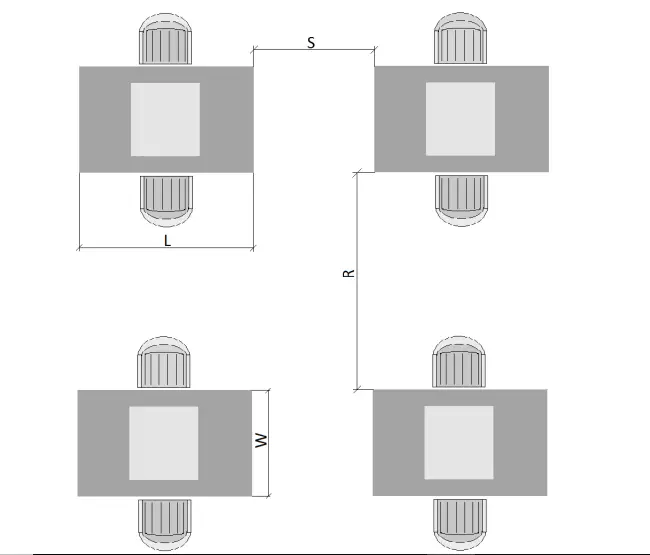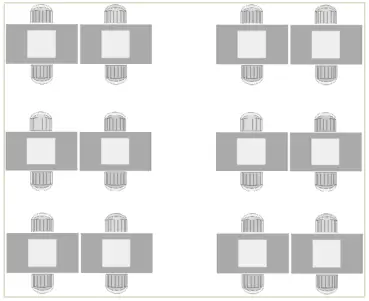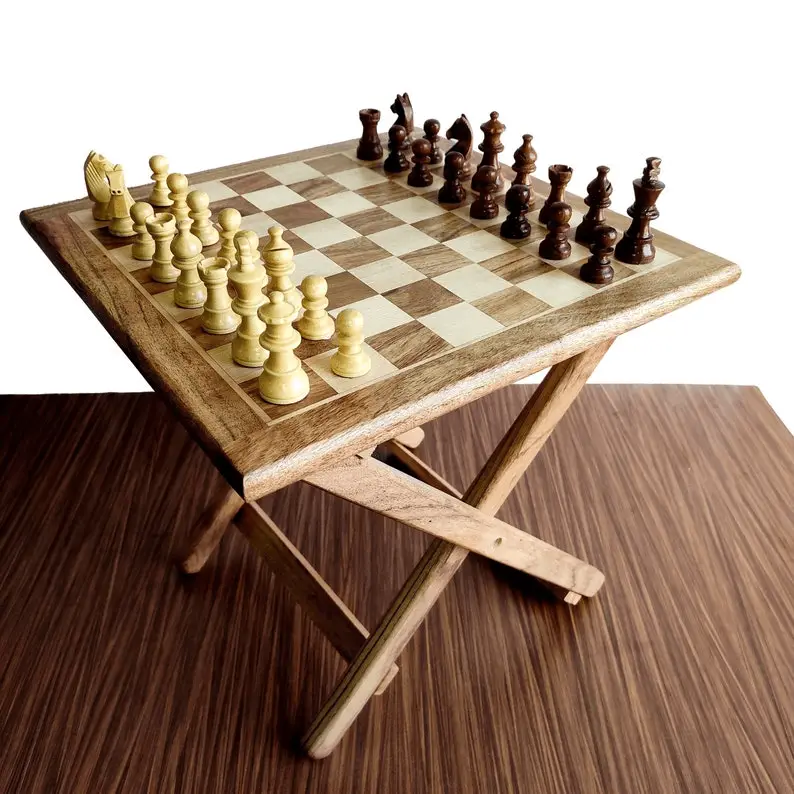A chess table is a piece of furniture that makes it useful for playing the game of chess. They can be classified in 2 groups: FIDE regulated chess tables and non FIDE regulated chess tables.
For competitive play such as chess tournaments, it is required for tournament organizers to follow the general guidelines of the chess table dimensions outlined by FIDE.
In this article, we will look at the official chess table dimensions and how to set up the chess tables in the playing hall. We will also share some unique chess table designs that are non FIDE regulated.
These types of tables are a perfect addition to the home or outside area.
Chess Table Dimensions in cm
For official FIDE tournaments, the dimensions of a chess table should be 110 cm in length, 85 cm in width, and 75 cm for the height of the table. There is a 15% tolerance for the length of the table, and the width is at least 15cm for each player.
This size chess table offers enough space and room for a chess board as large as 21″x21″ which is a typical size for tournament chess boards.
These measurements can be found in article 4 of the FIDE handbook “Standard of Chess Equipment”. It’s also important to note that adequate space must be provided for players and arbiters in the playing hall.
It is recommended that the minimal space of 4 square meters be available for each player in individual matches and round robin tournaments. For other tournaments 2 square meters may be adequate. The diagram below shows an overhead shot of the chess table dimensions and the space between the tables.
Chess Table Dimensions and space between tables

| Dimensions | Size | Tolerances | |
| L | Length of the table | 110cm | +20 cm, -10 cm |
| W | Width of the table | 85cm | +5 cm, -5 cm |
| S | Horizontal space between table rows | 3 meters | +1.5 m, -0.5 m |
| R | Vertical space between table rows | 3 meters | +1.5 m, -0.5 m |
Length Of Rows
According to FIDE, the length between the rows of players should be a minimum of 2.5 meters. It’s recommended not to have long, unbroken rows. Where possible, players should play on individual tables at least for top boards or top matches in the events.
The diagrams below show the setup of the chess tables in the tournament playing hall for different style of competitions.
Single row: Chess table setup for individual competitions

Dual Row: For large events (open tournaments, youth champ. etc) An arbiter may check two tables in the same time

Multi Row: For team competitions (should be avoided for individual events as much as possible)

Non FIDE Regulated Size Chess Tables
Non Fide regulated chess tables are tables that are not suitable for official FIDE tournaments.
These tables are more built for recreational purposes and can be installed outside at the park or inside in your home to add a beautiful touch.
These tables can come in all shapes and sizes from round, square and rectangle shape tabletop to octogonal surfaces. Some of these tables are also designed with built-in drawers so you can store the chess pieces inside.
If you are looking to make or buy a non FIDE chess table, here are some ideas that may spark your interest.
Rounded Chess Tables

If you want to go with something different other than a square chess table, then one option is a rounded chess table top.
Rounded chess tables are quite rare and they usually have a beautiful framework at the bottom as you can see from the photo above.
A chess board is typically imprinted on the surface so you can play chess without a physical board. Most importantly, the dimensions of the chess table provides enough space for you to play the game on.
This rounded chess table measures 20″ x 20″ x 20″ in size. You can click here to check it out on Etsy store
Octogonal Shaped Chess Table
If you want a stylish and unique chess table, then an octogonal chess table is what you may be looking for. There are 8 sides to an octogonal chess tabletop. Each side directly proportional to the other.

The dimension for this octogonal chess table is 40 x 40 x 4 (cm) or 16 x 16 x 2 (in). The table height is 50 (cm) or 20 (in). The individual square size of the imprinted chess board is 3.5 x 3.5 (cm) or 1.5 x 1.5(in) approximately.
As you can see, these measurements do not comply with FIDE individual square size regulations of 2″-2.5″. Nonetheless, this unique chess board makes for a great addition inside the home. Click here to check it out
Square Chess Tables

These chess tables are much smaller compared to the FIDE official chess table. There is not enough space to rest even a chess clock or scoresheet to the side. It’s defintely not made for tournament competitions.
However, these small chess tables are an excellent travel companion for players on the go as the wooden stand is folded with the chess board. They are portable and are built with storage to accommodate your chess pieces.
The size of this chess table is 12 x 12x 15 inches. Click here to check it out
Large Chess Table Vs Small Chess Table
For competitive chess tournaments, a larger chess table is always more ideal than a smaller chess table. Here are 4 reasons why it’s better to have a larger chess table.
There is space to rest the clock
We should remember that the chess clock is a crucial part of the game. As a result, there must be enough space for the chess clock to rest on the table.
Tables with less space can cause the chess clock to fall off the chess table as players hit their side of the clock back and forth.
This is especially true in blitz games when adrenalin is rushing and players accidentally hit over the clock onto the ground. A table with large enough space can prevent these incidences from occuring.
There is space to rest your scoresheet
In many classical tournaments, it is required for players to write their moves down on the scoresheet during the chess match. The scoresheet usually goes to the right of the chess player. Therefore, chess tables should be built with enough space to accommodate players to write down their moves on the scoresheet.
A small chess table will not cut it in official tournaments because there simply isn’t enough space to rest both the chess clock and scoresheet.
Final Thoughts
Having the right playing surface is important in a chess game. Players need to feel comfortable and at ease when playing their moves over the board, pressing the clock, or writing down their moves on a scoresheet. A FIDE regulated size chess table helps players achieve this level of comfort and not having to worry about shortage of space.
For more information on chess tables, see article: Top 10 best chess tables


